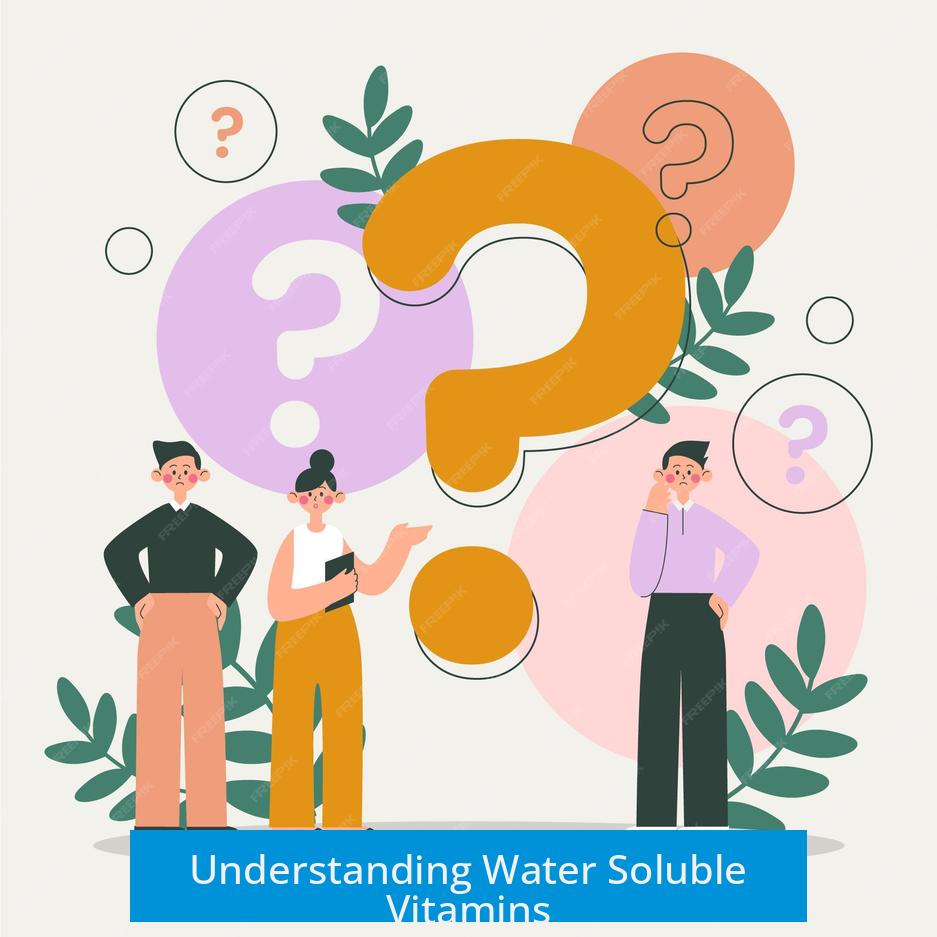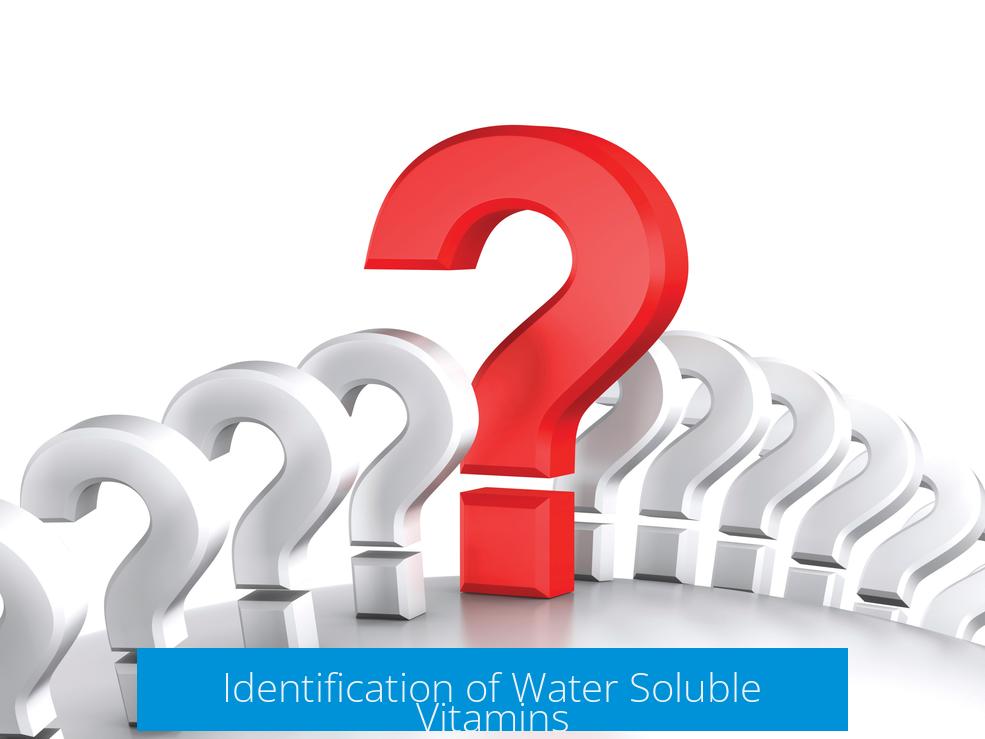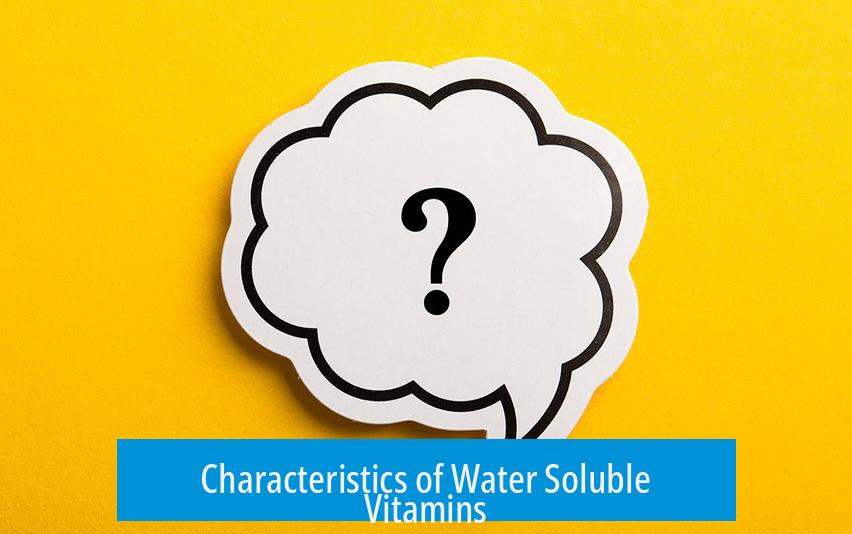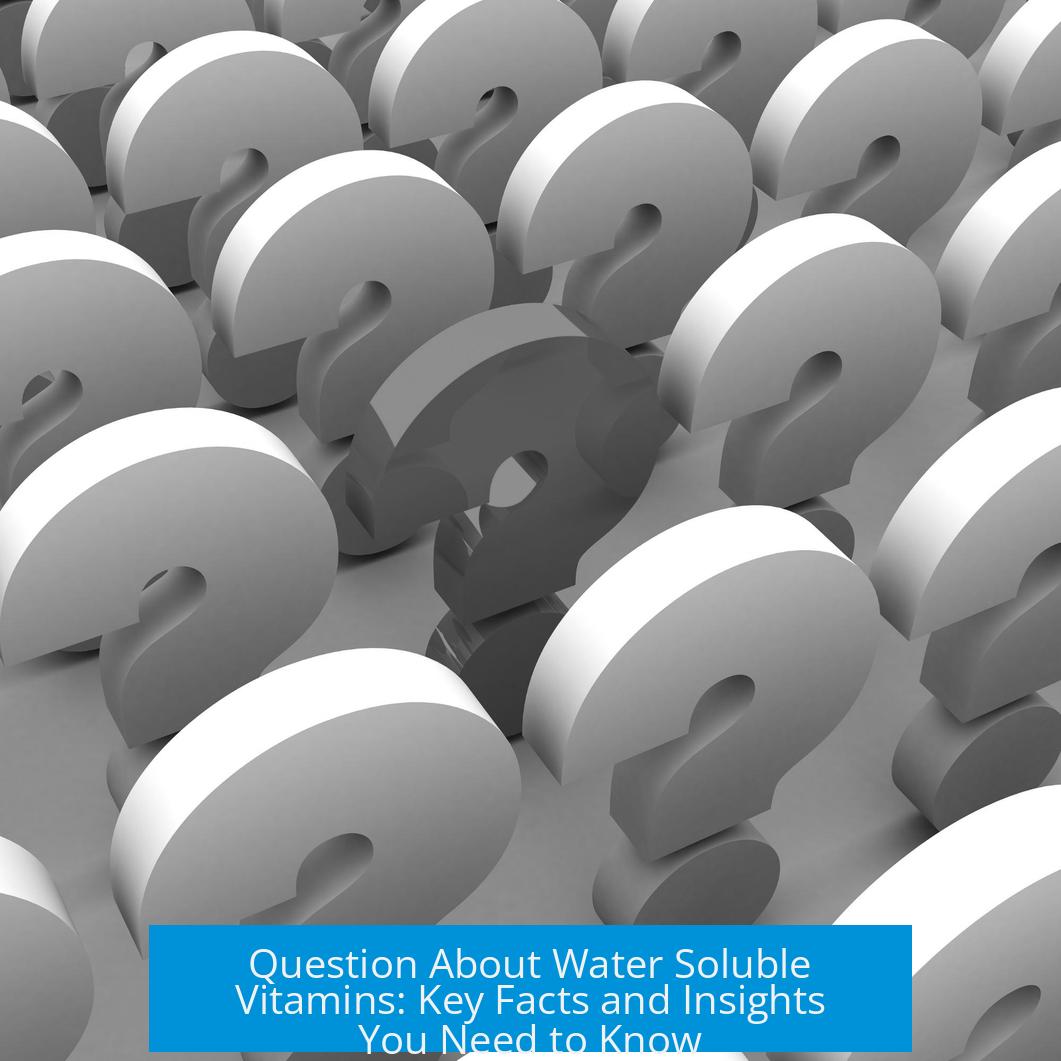Understanding Water Soluble Vitamins

Water-soluble vitamins include vitamin C and all B-complex vitamins such as B1 (thiamin), B2 (riboflavin), B3 (niacin), B5 (pantothenic acid), B6 (pyridoxine), B7 (biotin), B9 (folate), and B12 (cobalamin). These vitamins dissolve in water and are readily absorbed by the body’s fluids.
Identification of Water Soluble Vitamins

- Vitamin C
- B-Complex Vitamins: B1 (thiamin), B2 (riboflavin), B3 (niacin), B5 (pantothenic acid), B6 (pyridoxine), B7 (biotin), B9 (folate), B12 (cobalamin)
Unlike fat-soluble vitamins such as A, D, E, and K, water-soluble vitamins cannot dissolve in fats and are not stored extensively in fatty tissues or the liver.
Characteristics of Water Soluble Vitamins

Water-soluble vitamins dissolve easily in the water content of foods and body fluids. Unlike fat-soluble vitamins, they move quickly through the body, which limits their storage and increases the need for regular intake.
Because the body does not store these vitamins for long periods, frequent consumption through diet or supplements is necessary to maintain adequate levels.

Critical Functions and Benefits
Water-soluble vitamins play essential roles in maintaining overall health. They contribute to brain function, energy metabolism, and immune support.
For example:
- Vitamin C acts as a powerful antioxidant and aids in maintaining healthy skin and bones.
- Thiamin (Vitamin B1) supports energy production by converting nutrients into usable energy.
- Riboflavin (Vitamin B2) maintains healthy blood vessels by regulating amino acid homocysteine levels.
Frequent Replenishment Needed
Due to rapid excretion via urine, water-soluble vitamins require regular consumption. Missing these vitamins for a few days may lead to deficiency symptoms.
Toxicity Considerations
Generally, water-soluble vitamins present a low risk of toxicity because excess amounts leave the body quickly. However, very high doses of niacin (B3) and pyridoxine (B6) can cause adverse effects.
The best approach is to consume water-soluble vitamins within the recommended daily intake ranges.
Comparison with Fat-Soluble Vitamins
| Feature | Water-Soluble Vitamins | Fat-Soluble Vitamins |
|---|---|---|
| Storage in Body | Not stored, excreted rapidly | Stored in fat tissues and liver |
| Solubility | Dissolve in water | Dissolve in fats |
| Risk of Toxicity | Low (unless excessive doses of B3 or B6) | Higher due to storage |
| Examples | Vitamin C, B vitamins | Vitamins A, D, E, K |
Stability and Decomposition of Water Soluble Vitamins
The primary way water-soluble vitamins degrade is through oxidation by oxygen in the air. AIR and light exposure accelerate breakdown, leading to loss of potency over time.
Measures to preserve vitamin stability include:
- Storing in airtight containers to limit oxygen exposure
- Refrigerated storage to slow degradation rates
- Use of antioxidants like vitamin C to inhibit oxidation
Vitamin C, with its antioxidant properties, is commonly added to food and supplement formulations to prevent decomposition of other vitamins.
Food Sources and Recommended Intakes
Water-soluble vitamins are abundant in various foods, including fruits, vegetables, whole grains, lean meats, and dairy products.
| Vitamin | Common Food Sources | FDA Recommended Daily Intake |
|---|---|---|
| Vitamin C | Citrus fruits, strawberries, bell peppers, broccoli | 90 mg for adults and children 4+ years |
| Vitamin B1 (Thiamin) | Whole grains, pork, nuts, legumes | 1.2 mg for adults and children 4+ years |
| Vitamin B2 (Riboflavin) | Milk, eggs, almonds, green leafy vegetables | 1.3 mg for adults and children 4+ years |
Role of Minerals Related to Water Solubility
Essential minerals differ from vitamins in that they usually exist as soluble salts and generally remain stable during storage and digestion. Minerals such as magnesium, zinc, calcium, iron, sodium, and potassium are all important for health.
Sodium and potassium intake is typically sufficient through a balanced diet. Magnesium and zinc also serve vital roles in enzyme function and immune health.
Summary of Key Points
- Water-soluble vitamins include vitamin C and all B-complex vitamins.
- These vitamins dissolve in water and are not stored extensively in the body.
- Frequent intake is necessary to maintain adequate levels due to rapid excretion.
- Vitamin C acts as both a vitamin and antioxidant, protecting other vitamins from oxidation.
- Toxicity is rare but possible with very high doses of niacin and pyridoxine.
- Fat-soluble vitamins differ by being stored in the body’s fat tissues.
- Proper storage—airtight and refrigerated—helps preserve vitamin potency.
- Daily recommended intakes vary; for example, 90 mg vitamin C and 1.2-1.3 mg for B1 and B2.
Question about Water-Soluble Vitamins: What You Really Need to Know
Water-soluble vitamins are nutrients that dissolve in water and move quickly through the body, which means you need them regularly. These vitamins include vitamin C and all the B vitamins, like thiamin, riboflavin, niacin, and others. But that’s just the start. There’s much more to understand about these essential vitamins: how they behave, why you need them often, and how to keep their benefits intact.
Let’s unravel the mysteries around water-soluble vitamins — without turning this into a dry lecture. Ready? Here we go!
What Exactly Are Water-Soluble Vitamins?
First things first, it’s important to identify which vitamins fall under the “water-soluble” category. Simply put, if it dissolves in water, it’s in this group. This includes vitamin C and the whole B-complex family:
- Vitamin B1 (Thiamin)
- Vitamin B2 (Riboflavin)
- Vitamin B3 (Niacin)
- Vitamin B5 (Pantothenic acid)
- Vitamin B6 (Pyridoxine)
- Vitamin B7 (Biotin)
- Vitamin B9 (Folate)
- Vitamin B12 (Cobalamin)
Notably, omega-3 and vitamins D, A, and E are not water-soluble; they dissolve in fat instead. So, keep them in a different vitamin basket!
Vitamin Storage: Why Water Solubles Don’t Hang Around Long
Unlike fat-soluble vitamins, which our bodies store in fat tissues for later use, water-soluble vitamins do not have a long-term home in the body.
They travel through the watery spaces in your body and excrete quickly through urine. This rapid turnover means the body requires you to replace them daily or at least frequently. Ever notice how you’re always told to snack on fruits or leafy greens? That’s why.
Benefits of Water-Soluble Vitamins: Beyond the Basics
Now, you might immediately think “Vitamin C = immune support” and that’s right. But water-soluble vitamins do a lot more.
- Vitamin C protects your cells with antioxidant power, supports your skin’s structure, and helps heal wounds.
- B1 (Thiamin) transforms the food you eat into fuel for your cells, powering your brain and muscles.
- B2 (Riboflavin) keeps your blood vessels healthy by regulating amino acids like homocysteine, which can otherwise cause dangerous clots.
Imagine these vitamins as tiny helpers who keep your body’s engines running smoothly, your immune system sharp, and your skin glowing.
How to Keep Water-Soluble Vitamins from Breaking Down
Here’s where things get a little tricky. Water-soluble vitamins are more fragile than their fat-soluble cousins. The main villain in their story? Oxygen.
Exposure to oxygen causes oxidation, which breaks down these vitamins and makes them less effective. That’s why you want to store your vitamin-rich foods and supplements carefully.
Tip: Keep liquids or powders containing these vitamins in airtight bottles to cut off the oxygen supply. Even better, include vitamin C, a powerful natural antioxidant, in the mix. Vitamin C acts as a defender, preventing other vitamins from decomposing while also doing double duty as a nutrient.
Storing your vitamin blends in the fridge slows down their breakdown without introducing anything toxic. So, don’t hesitate to chill those bottles for longer shelf life.
Is There Any Risk of Vitamin Toxicity?
Because water-soluble vitamins don’t stay long inside the body, the chances of toxicity are pretty low. Your body simply flushes out what it doesn’t need.
But there’s a tiny catch: excessive intake of some B vitamins like niacin or pyridoxine (B6) can cause side effects if you go way overboard with supplements. Always stick close to the recommended daily values.
Recommended Daily Intake? Here’s a Quick Look
The U.S. Food and Drug Administration gives these guidelines for older kids and adults:
- Vitamin C: 90 milligrams daily
- Vitamin B1 (Thiamin): 1.2 milligrams daily
- Vitamin B2 (Riboflavin): 1.3 milligrams daily
These numbers may seem small, but meeting them regularly supports many bodily functions.
Food Sources: Where to Find These Little Powerhouses
No need to dive into expensive supplements if you eat a balanced diet. Rich sources include:
- Citrus fruits, strawberries, and bell peppers (vitamin C)
- Whole grains and fortified cereals (various B vitamins)
- Meats and eggs (B12 and others)
- Leafy greens and legumes (folate/ B9)
Incorporate variety and color—nature’s best vitamin package.
What About Minerals? Are They Water Soluble?
Unlike vitamins, essential minerals act differently. They usually appear as soluble salts rather than vitamins and don’t break down like vitamins do.
Important minerals include calcium, iron, magnesium, and zinc — vital for bone health, oxygen transport, enzyme functions, and immunity. Sodium and potassium are common too, but most people get enough from their diets.
Fat-soluble vs Water-soluble: Why Does It Matter?
Knowing the difference helps you understand absorption and storage better.
- Fat-soluble vitamins (A, D, E, K) absorb in the intestines along with fats. Body stores them in fat tissues, so they accumulate if taken excessively.
- Water-soluble vitamins absorb in water-rich parts of the intestine and flush out quickly, requiring frequent intake.
So next time you look at your vitamins, you’ll know why eating meals with a little fat helps with fat-soluble vitamins, while water-solubles are a daily priority.
Takeaway: How to Maximize the Power of Water-Soluble Vitamins
1. Eat fresh and varied foods to keep your vitamin C and Bs in check.
2. Store vitamin-rich foods and supplements airtight and cool to prevent oxidation.
3. Remember: regular intake beats mega-doses; more isn’t always better.
4. When combining nutrients, include vitamin C to boost protection.
Got Questions? Here’s One to Ponder
Given water-soluble vitamins don’t stay long inside us, how can your daily diet keep your system balanced — especially if you’re constantly on the go or don’t get fresh produce every day? Maybe the answer isn’t one-time megadoses but steady, consistent nutrition and smart food choices.
Consider planning balanced meals, perhaps backed by a trusted multivitamin, to keep your body’s vital processes humming smoothly. And remember: your body loves variety and a fridge!
Water-soluble vitamins aren’t just a health fad—they’re crucial nutrients that keep your body’s core functions firing. Treat them well with proper storage and daily attention, and they’ll reward you with energy, a strong immune system, and overall wellness.
What vitamins are classified as water-soluble?
Water-soluble vitamins include vitamin C and the B-complex group. This group has nine vitamins like thiamin (B1), riboflavin (B2), niacin (B3), and folate (B9). These vitamins dissolve in water and are not stored in the body.
Why do water-soluble vitamins need to be consumed regularly?
These vitamins move through the body quickly and do not stay stored for long. Because they dissolve in water, the body absorbs them fast but also excretes them fast, making frequent intake necessary to maintain levels.
Can water-soluble vitamins cause toxicity?
Toxicity is rare since the body flushes out excess amounts. However, taking very large doses of niacin (B3) or pyridoxine (B6) can cause adverse effects. It’s best to stick to the recommended daily intake.
How does vitamin C help preserve other vitamins?
Vitamin C acts as a water-soluble antioxidant. It prevents oxidation which can decompose other vitamins in a mixture. That is why it is often added to packaged foods as a preservative.
What is the main cause of water-soluble vitamin degradation?
Oxidation by oxygen in the air is the primary way these vitamins break down. Storing them in airtight containers and keeping them refrigerated slows this process.
How do water-soluble vitamins differ from fat-soluble vitamins?
Water-soluble vitamins dissolve in water and are not stored in fat tissue. Fat-soluble vitamins like A and D dissolve in fats and are stored in the body for longer periods when not in use.





Leave a Comment